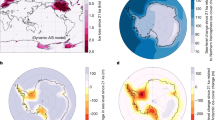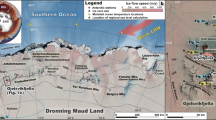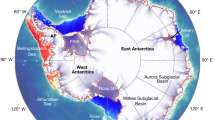Abstract
The West Antarctic ice sheet (WAIS), with ice volume equivalent to ∼5 m of sea level1, has long been considered capable of past and future catastrophic collapse2,3,4. Today, the ice sheet is fringed by vulnerable floating ice shelves that buttress the fast flow of inland ice streams. Grounding lines are several hundred metres below sea level and the bed deepens upstream, raising the prospect of runaway retreat3,5. Projections of future WAIS behaviour have been hampered by limited understanding of past variations and their underlying forcing mechanisms6,7. Its variation since the Last Glacial Maximum is best known, with grounding lines advancing to the continental-shelf edges around ∼15 kyr ago before retreating to near-modern locations by ∼3 kyr ago8. Prior collapses during the warmth of the early Pliocene epoch9 and some Pleistocene interglacials have been suggested indirectly from records of sea level and deep-sea-core isotopes, and by the discovery of open-ocean diatoms in subglacial sediments10. Until now11, however, little direct evidence of such behaviour has been available. Here we use a combined ice sheet/ice shelf model12 capable of high-resolution nesting with a new treatment of grounding-line dynamics and ice-shelf buttressing5 to simulate Antarctic ice sheet variations over the past five million years. Modelled WAIS variations range from full glacial extents with grounding lines near the continental shelf break, intermediate states similar to modern, and brief but dramatic retreats, leaving only small, isolated ice caps on West Antarctic islands. Transitions between glacial, intermediate and collapsed states are relatively rapid, taking one to several thousand years. Our simulation is in good agreement with a new sediment record (ANDRILL AND-1B) recovered from the western Ross Sea11, indicating a long-term trend from more frequently collapsed to more glaciated states, dominant 40-kyr cyclicity in the Pliocene, and major retreats at marine isotope stage 31 (∼1.07 Myr ago) and other super-interglacials.
This is a preview of subscription content, access via your institution
Access options
Subscribe to this journal
Receive 51 print issues and online access
$199.00 per year
only $3.90 per issue
Buy this article
- Purchase on Springer Link
- Instant access to full article PDF
Prices may be subject to local taxes which are calculated during checkout



Similar content being viewed by others
References
Lythe, M. B. et al. BEDMAP: A new ice thickness and subglacial topographic model of Antarctica. J. Geophys. Res. Solid Earth 106 (B6) 11335–11351 (2001)
Mercer, J. H. West Antarctic ice sheet and CO2 greenhouse effect: A threat of disaster. Nature 271, 321–325 (1978)
Weertman, J. Stability of the junction of an ice sheet and an ice shelf. J. Glaciol. 13, 3–11 (1974)
Oppenheimer, M. & Alley, R. B. The West Antarctic ice sheet and long term climate policy – An editorial comment. Clim. Change 64, 1–10 (2004)
Schoof, C. Ice sheet grounding line dynamics: Steady states, stability, and hysteresis. J. Geophys. Res. 112 F03S28 10.1029/2006JF000664 (2007)
Ritz, C., Rommelaere, V. & Dumas, C. Modeling the evolution of Antarctic ice sheet over the last 420,000 years: Implications for altitude changes in the Vostok region. J. Geophys. Res. 106 (D23) 31943–31964 (2001)
Huybrechts, P. Sea-level changes at the LGM from ice-dynamic reconstructions of the Greenland and Antarctic ice sheets during the glacial cycles. Quat. Sci. Rev. 21, 203–231 (2002)
Anderson, J. B. Antarctic Marine Geology (Cambridge Univ. Press, 1999)
Ravelo, A. C. et al. Regional climate shifts caused by gradual global cooling in the Pliocene epoch. Nature 429, 263–267 (2004)
Scherer, R. P. Quaternary and Tertiary microfossils from beneath Ice Stream-B – Evidence for a dynamic West Antarctic Ice-Sheet History. Glob. Planet. Change 90, 395–412 (1991)
Naish, T. et al. Obliquity-paced, Pliocene West Antarctic ice sheet oscillations. Nature (this issue).
Pollard, D. & DeConto, R. M. in Glacial Sedimentary Processes and Products (eds Hambrey, M., Christoffersen, P., Glasser, N. & Hubbard, B.) 37–52 (Spec. Publ. 39, International Association of Sedimentologists, Blackwell Publishing, 2007)
Pattyn, F. A new three-dimensional higher-order thermomechanical ice sheet model: Basic sensitivity, ice stream development, and ice flow across subglacial lakes. J. Geophys. Res. 108 (B8). 2382 10.1029/2002JB002329 (2003)
Beckmann, A. & Goose, H. A parameterization of ice shelf-ocean interaction for climate models. Ocean Model. 5, 157–170 (2003)
Rignot, E. & Jacobs, S. S. Rapid bottom melting widespread near Antarctic ice sheet grounding lines. Science 296, 2020–2023 (2002)
Shepherd, A., Wingham, D. & Rignot, E. Warm ocean is eroding West Antarctic Ice Sheet. Geophys. Res. Lett. 31 L23402 10.1029/2004GL021106 (2004)
Philippon, G. et al. Evolution of the Antarctic ice sheet throughout the last deglaciation: A study with a new coupled climate - north and south hemisphere ice sheet model. Earth Planet. Sci. Lett. 248, 750–758 (2006)
Lisiecki, L. E. & Raymo, M. E. A. Pliocene-Pleistocene stack of 57 globally distributed benthic δ18O records. Paleoceanography 20 PA1003 10.1029/2005PA001153 (2005)
Holland, P. R. & Jenkins, A. The response of ice shelf basal melting to variations in ocean temperature. J. Clim. 21, 2558–2572 (2008)
Laskar, J. et al. A long-term numerical solution for the insolation quantities of the Earth. Astron. Astrophys. 428, 261–285 (2004)
Scherer, R. P. et al. Antarctic records of precession-paced insolation-driven warming during early Pleistocene Marine Isotope Stage 31. Geophys. Res. Lett. 35 L03505 10.1029/2007GL032254 (2008)
Hill, D. J., Haywood, A. M., Hindmarsh, R. C. A. & Valdes, P. J. in Deep Time Perspectives on Climate Change: Marrying the Signals from Computer Models and Biological Proxies (eds Williams, M., Haywood, A. M., Gregory, F. J. & Schmidt, D. N.) 517–538 (Micropaleontological Society Special Publications, Geological Society, 2007)
O'Brien, P. E. et al. Late Neogene ice drainage changes in Prydz Bay, East Antarctica and the interaction of Antarctic ice sheet evolution and climate. Palaeogeogr. Palaeoclimatol. Palaeoecol. 245, 390–410 (2007)
Conway, H. et al. Past and future grounding-line retreat of the West Antarctic Ice Sheet. Science 286, 280–283 (1999)
McKay, R. M. et al. Retreat history of the Ross Ice Sheet (Shelf) since the Last Glacial Maximum from deep-basin sediment cores around Ross Island. Palaeogeogr. Palaeoclimatol. Palaeoecol. 260, 245–261 (2008)
Hearty, P. J. et al. Global sea-level fluctuations during the Last Interglaciation (MIS 5e). Quat. Sci. Rev. 26, 2090–2112 (2007)
Raynaud, D. et al. in Earth's Climate and Orbital Eccentricity: The Marine Isotope Stage 11 Question (eds Droxler, A. W., Poore, R. Z. & Burckle, L. H.) 27–40 (American Geophysical Union, 2003)
Lisiecki, L. E., Raymo, M. E. & Curry, W. B. Atlantic overturning responses to Late Pleistocene climate forcings. Nature 456, 85–88 (2008)
Huybers, P. & Denton, G. Antarctic temperature at orbital timescales controlled by local summer duration. Nature Geosci. 1, 787–792 (2008)
Kawamura, K. et al. Northern Hemisphere forcing of climatic cycles in Antarctica over the past 360,000 years. Nature 448, 912–916 (2007)
Hulbe, C. & Fahnestock, M. Century-scale discharge stagnation and reactivation of the Ross ice streams, West Antarctica. J. Geophys. Res. 112 F03S27 10.1029/2006JF000603 (2007)
Pollard, D. & DeConto, R. M. Hysteresis in Cenozoic Antarctic ice sheet variations. Glob. Planet. Change 45, 9–21 (2005)
Huybrechts, P. Glaciological modelling of the late Cenozoic East Antarctic Ice Sheet: Stability or dynamism? Geogr. Ann. A 75, 221–238 (1993)
Huybrechts, P. Report of the Third EISMINT Workshop on Model Intercomparison (European Science Foundation, 1998)
Marshall, S. J. & Clarke, G. K. C. Ice sheet inception: Subgrid hypsometric parameterization of mass balance in an ice sheet model. Clim. Dyn. 15, 533–550 (1999)
Macayeal, D. R. & Thomas, R. H. The effects of basal melting on the present flow of the Ross Ice Shelf, Antarctica. J. Glaciol. 32, 72–86 (1986)
Dinniman, M. S., Klinck, J. M. & Smith, W. O. Influence of sea ice cover and icebergs on circulation and water mass formation in a numerical circulation model of the Ross Sea, Antarctica. J. Geophys. Res 112 C11013 10.1029/2006JC004036 (2007)
Acknowledgements
We thank T. Naish and R. Powell for discussions on this work, and P. Barrett for comments on the manuscript. This work was funded by the US National Science Foundation under awards ATM-0513402/0513421, ANT-034248 and ANT-0424589.
Author information
Authors and Affiliations
Corresponding author
Supplementary information
Supplementary Information
This file contains, Supplementary Data and Notes, Supplementary Figures S1-S8 with Legends, Supplementary References and Supplementary Video Legends. (PDF 3918 kb)
Supplementary Video 1
This video shows simulated Antarctic ice elevations/thicknesses from 400 ka to the present (see file s1 for full legend). (MOV 5926 kb)
Supplementary Video 2
This video shows simulated Antarctic ice elevations/thicknesses from 1.7 Ma to 0.6 Ma (see file s1 for full legend). (MOV 8188 kb)
Supplementary Video 3
This video shows model ice velocities for an 8000-year high-resolution nested simulation (see file s1 for full legend). (MOV 5258 kb)
Supplementary Video 4
This video shows model ice basal temperatures for an 8000-year high-resolution nested simulation (see file s1 for full legend). (MOV 5258 kb)
Rights and permissions
About this article
Cite this article
Pollard, D., DeConto, R. Modelling West Antarctic ice sheet growth and collapse through the past five million years. Nature 458, 329–332 (2009). https://doi.org/10.1038/nature07809
Received:
Accepted:
Issue Date:
DOI: https://doi.org/10.1038/nature07809
This article is cited by
-
Deglaciation-enhanced mantle CO2 fluxes at Yellowstone imply positive climate feedback
Nature Communications (2024)
-
A thicker Antarctic ice stream during the mid-Pliocene warm period
Communications Earth & Environment (2023)
-
Scars of tectonism promote ice-sheet nucleation from Hercules Dome into West Antarctica
Nature Geoscience (2023)
-
A topographic hinge-zone divides coastal and inland ice dynamic regimes in East Antarctica
Communications Earth & Environment (2023)
-
East Antarctica ice sheet in Schirmacher Oasis, Central Dronning Maud Land, during the past 158 ka
Proceedings of the Indian National Science Academy (2023)
Comments
By submitting a comment you agree to abide by our Terms and Community Guidelines. If you find something abusive or that does not comply with our terms or guidelines please flag it as inappropriate.



